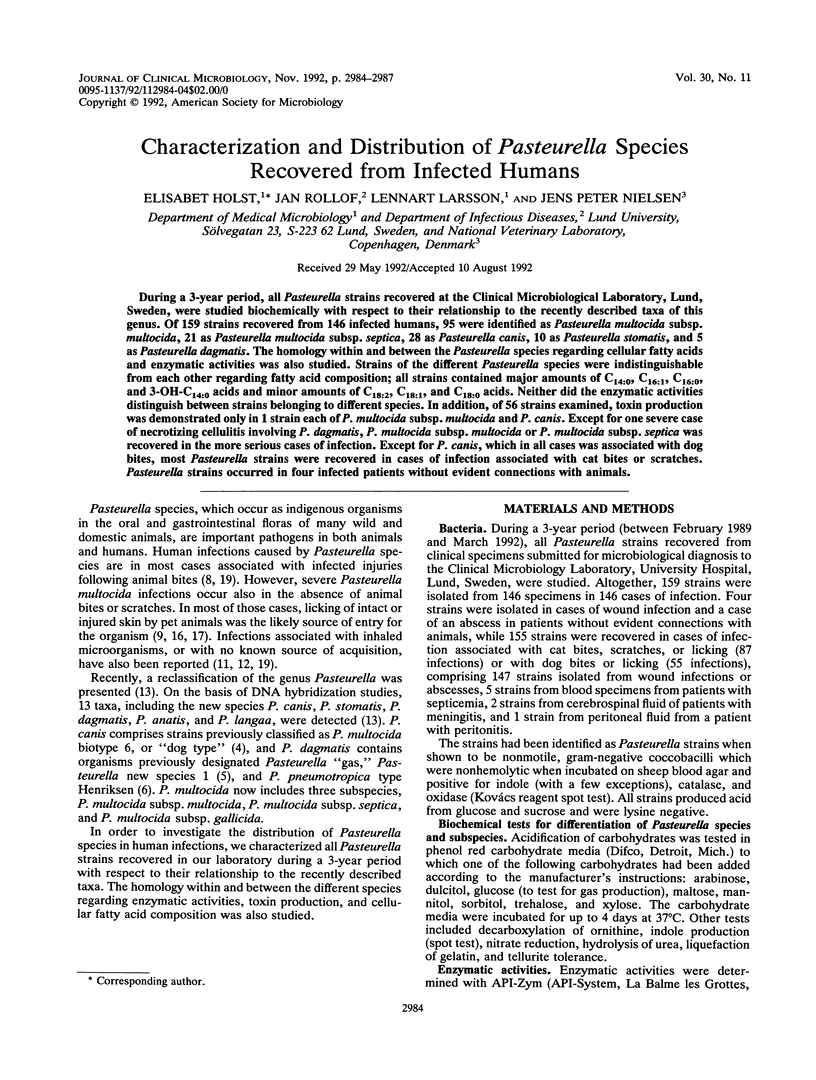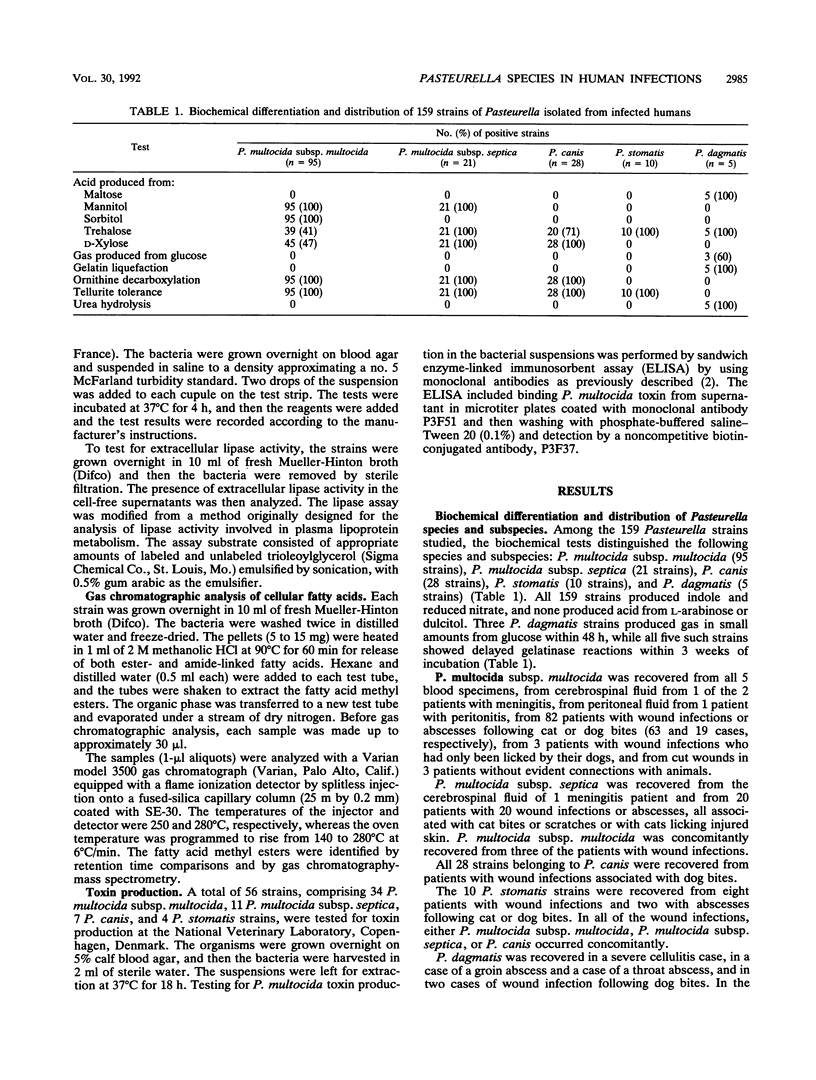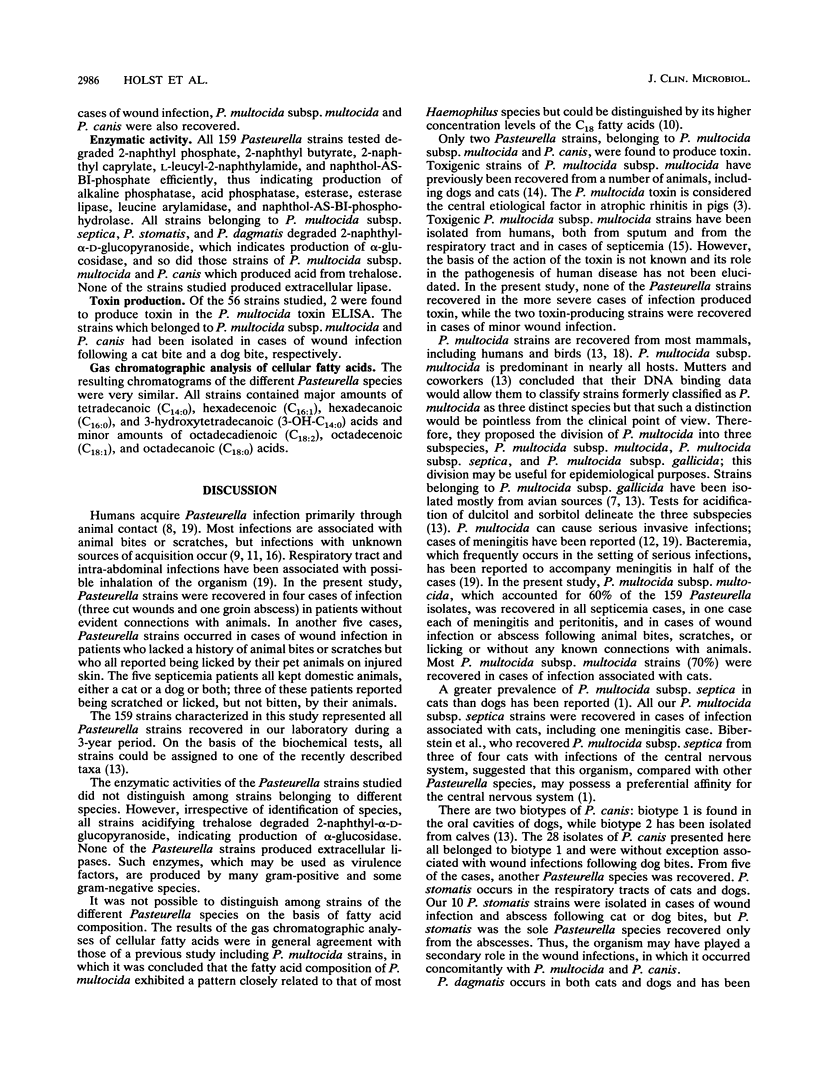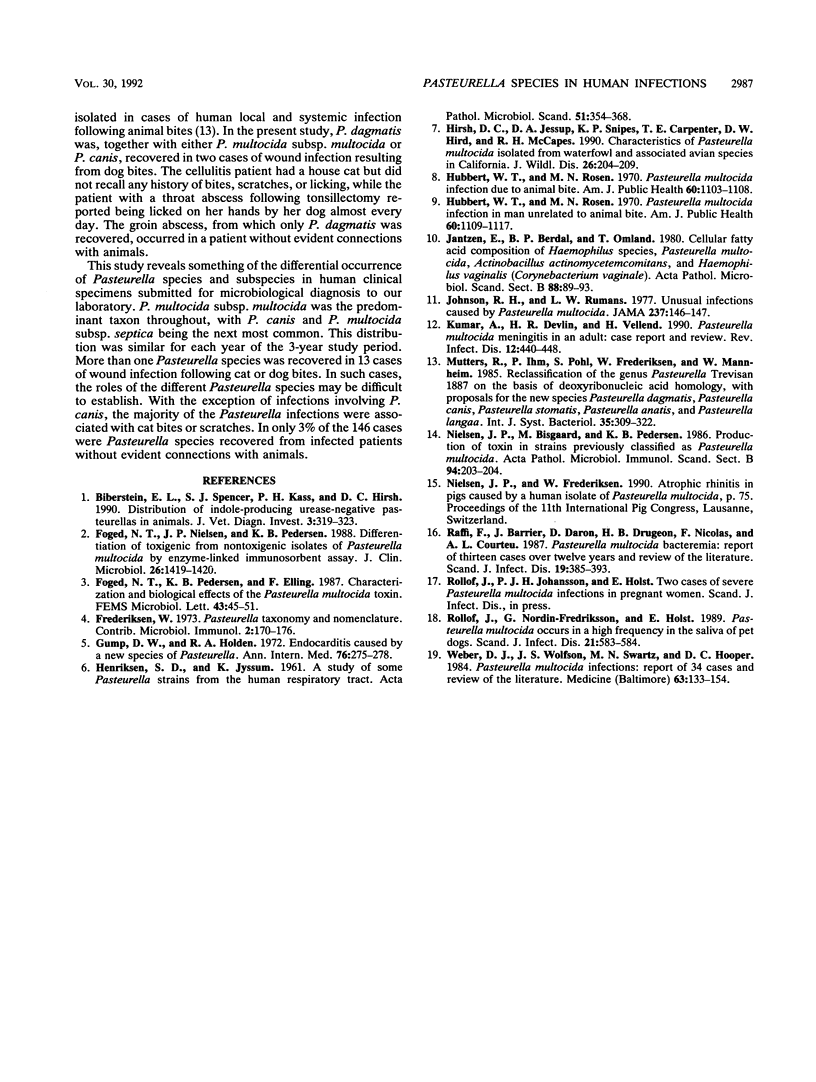Abstract
During a 3-year period, all Pasteurella strains recovered at the Clinical Microbiological Laboratory, Lund, Sweden, were studied biochemically with respect to their relationship to the recently described taxa of this genus. Of 159 strains recovered from 146 infected humans, 95 were identified as Pasteurella multocida subsp. multocida, 21 as Pasteurella multocida subsp. septica, 28 as Pasteurella canis, 10 as Pasteurella stomatis, and 5 as Pasteurella dagmatis. The homology within and between the Pasteurella species regarding cellular fatty acids and enzymatic activities was also studied. Strains of the different Pasteurella species were indistinguishable from each other regarding fatty acid composition; all strains contained major amounts of C14:0, C16:1, C16:0, and 3-OH-C14:0 acids and minor amounts of C18:2, C18:1, and C18:0 acids. Neither did the enzymatic activities distinguish between strains belonging to different species. In addition, of 56 strains examined, toxin production was demonstrated only in 1 strain each of P. multocida subsp. multocida and P. canis. Except for one severe case of necrotizing cellulitis involving P. dagmatis, P. multocida subsp. multocida or P. multocida subsp. septica was recovered in the more serious cases of infection. Except for P. canis, which in all cases was associated with dog bites, most Pasteurella strains were recovered in cases of infection associated with cat bites or scratches. Pasteurella strains occurred in four infected patients without evident connections with animals.
Full text
PDF



Selected References
These references are in PubMed. This may not be the complete list of references from this article.
- Biberstein E. L., Jang S. S., Kass P. H., Hirsh D. C. Distribution of indole-producing urease-negative pasteurellas in animals. J Vet Diagn Invest. 1991 Oct;3(4):319–323. doi: 10.1177/104063879100300408. [DOI] [PubMed] [Google Scholar]
- Foged N. T., Nielsen J. P., Pedersen K. B. Differentiation of toxigenic from nontoxigenic isolates of Pasteurella multocida by enzyme-linked immunosorbent assay. J Clin Microbiol. 1988 Jul;26(7):1419–1420. doi: 10.1128/jcm.26.7.1419-1420.1988. [DOI] [PMC free article] [PubMed] [Google Scholar]
- Gump D. W., Holden R. A. Endocarditis caused by a new species of Pasteurella. Ann Intern Med. 1972 Feb;76(2):275–278. doi: 10.7326/0003-4819-76-2-275. [DOI] [PubMed] [Google Scholar]
- HENRIKSEN S. D., JYSSUM K. A study of some Pasteurella strains from the human respiratory tract. Acta Pathol Microbiol Scand. 1961;51:354–368. doi: 10.1111/j.1699-0463.1961.tb00374.x. [DOI] [PubMed] [Google Scholar]
- Hirsh D. C., Jessup D. A., Snipes K. P., Carpenter T. E., Hird D. W., McCapes R. H. Characteristics of Pasteurella multocida isolated from waterfowl and associated avian species in California. J Wildl Dis. 1990 Apr;26(2):204–209. doi: 10.7589/0090-3558-26.2.204. [DOI] [PubMed] [Google Scholar]
- Hubbert W. T., Rosen M. N. Pasteurella multocida Infections: I. Pasteurella Multocida Infection Due to Animal Bite. Am J Public Health Nations Health. 1970 Jun;60(6):1103–1108. doi: 10.2105/ajph.60.6.1103. [DOI] [PMC free article] [PubMed] [Google Scholar]
- Hubbert W. T., Rosen M. N. Pasteurella multocida infections. II. Pasteurella multocida infection in man unrelated to animal bite. Am J Public Health Nations Health. 1970 Jun;60(6):1109–1117. doi: 10.2105/ajph.60.6.1109. [DOI] [PMC free article] [PubMed] [Google Scholar]
- Jantzen E., Berdal B. P., Omland T. Cellular fatty acid composition of Haemophilus species, Pasteurella multocida, Actinobacillus Actinomycetemcomitans and Haemophilus vaginalis (Corynebacterium vaginale). Acta Pathol Microbiol Scand B. 1980 Apr;88(2):89–93. doi: 10.1111/j.1699-0463.1980.tb02611.x. [DOI] [PubMed] [Google Scholar]
- Johnson R. H., Rumans L. W. Unusual infections caused by Pasteurella multocida. JAMA. 1977 Jan 10;237(2):146–147. [PubMed] [Google Scholar]
- Kumar A., Devlin H. R., Vellend H. Pasteurella multocida meningitis in an adult: case report and review. Rev Infect Dis. 1990 May-Jun;12(3):440–448. doi: 10.1093/clinids/12.3.440. [DOI] [PubMed] [Google Scholar]
- Nielsen J. P., Bisgaard M., Pedersen K. B. Production of toxin in strains previously classified as Pasteurella multocida. Acta Pathol Microbiol Immunol Scand B. 1986 Jun;94(3):203–204. doi: 10.1111/j.1699-0463.1986.tb03042.x. [DOI] [PubMed] [Google Scholar]
- Raffi F., Barrier J., Baron D., Drugeon H. B., Nicolas F., Courtieu A. L. Pasteurella multocida bacteremia: report of thirteen cases over twelve years and review of the literature. Scand J Infect Dis. 1987;19(4):385–393. doi: 10.3109/00365548709021670. [DOI] [PubMed] [Google Scholar]
- Rollof J., Nordin-Fredriksson G., Holst E. Pasteurella multocida occurs in a high frequency in the saliva of pet dogs. Scand J Infect Dis. 1989;21(5):583–584. doi: 10.3109/00365548909037889. [DOI] [PubMed] [Google Scholar]
- Weber D. J., Wolfson J. S., Swartz M. N., Hooper D. C. Pasteurella multocida infections. Report of 34 cases and review of the literature. Medicine (Baltimore) 1984 May;63(3):133–154. [PubMed] [Google Scholar]


